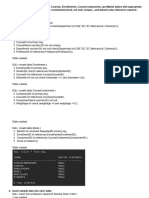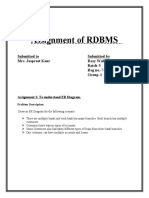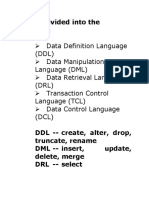0% found this document useful (0 votes)
24 views6 pagesSQL CRUD and Constraints Guide
The document provides SQL queries to perform CRUD operations on a database with tables for Students, Courses, and Enrollments. It includes queries to:
1) Insert new records into the Students, Courses, and Enrollments tables
2) Read and select data from the tables by joining them
3) Update a record in the Enrollments table
4) Delete a Student record and its associated enrollments using a cascading delete
It also defines several common SQL constraints like NOT NULL, UNIQUE, PRIMARY KEY, FOREIGN KEY and explains their purposes for enforcing data integrity and relationships between tables.
Uploaded by
I am ab YesCopyright
© © All Rights Reserved
We take content rights seriously. If you suspect this is your content, claim it here.
Available Formats
Download as DOCX, PDF, TXT or read online on Scribd
0% found this document useful (0 votes)
24 views6 pagesSQL CRUD and Constraints Guide
The document provides SQL queries to perform CRUD operations on a database with tables for Students, Courses, and Enrollments. It includes queries to:
1) Insert new records into the Students, Courses, and Enrollments tables
2) Read and select data from the tables by joining them
3) Update a record in the Enrollments table
4) Delete a Student record and its associated enrollments using a cascading delete
It also defines several common SQL constraints like NOT NULL, UNIQUE, PRIMARY KEY, FOREIGN KEY and explains their purposes for enforcing data integrity and relationships between tables.
Uploaded by
I am ab YesCopyright
© © All Rights Reserved
We take content rights seriously. If you suspect this is your content, claim it here.
Available Formats
Download as DOCX, PDF, TXT or read online on Scribd
/ 6






















































































